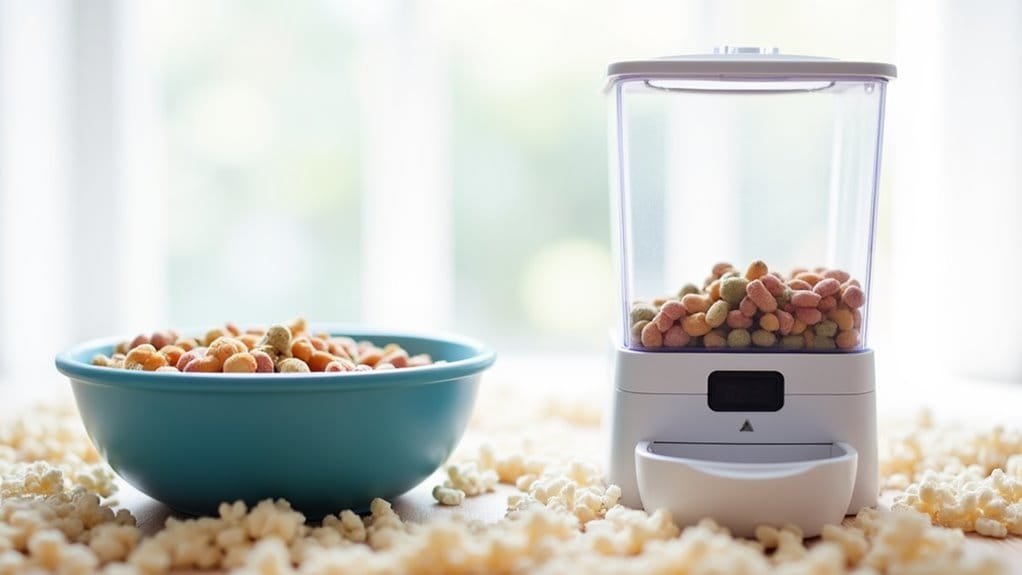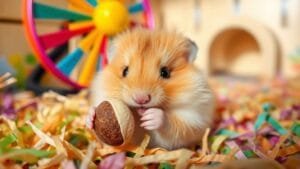When choosing between a food bowl and automatic feeder for your hamster, you’ve got two solid options. A basic food bowl is budget-friendly, simple to use, and needs daily cleaning and refilling – perfect if you’re home regularly. An automatic feeder costs more upfront ($20-$60) but saves time by dispensing pre-measured portions on schedule, great for busy pet parents. Your choice depends on your daily routine and your furry friend’s needs. Food bowls work well for most hamster parents, while automatic feeders offer convenience for those who aren’t always around at feeding time. There’s quite a bit more to evaluate when picking the perfect feeding setup for your little pal.
Understanding Hamster Feeding Options
Managing your hamster’s feeding routine requires careful contemplation of available options, from traditional bowls to modern automatic feeders. You’ll want to reflect on what works best for both you and your furry friend. After all, your hamster needs regular meals to stay healthy and happy!
When you’re looking at feeding options, you’ve got two main choices: good old-fashioned food bowls or fancy automatic feeders. Food bowls are simple and cheap, but they need daily refilling. Automatic feeders, on the other hand, can make your life easier by dispensing food on a set schedule. Think of them as tiny restaurant servers for your hamster! Most automatic feeders have adjustable kibble settings to accommodate different food sizes.
Here’s something to ponder: How often are you away from home? If you’re usually around, a regular bowl might do just fine. But if you’re busy or travel sometimes, an automatic feeder could be your best friend.
These smart gadgets can portion out food perfectly, just like having a personal chef for your hamster. Plus, they’ll keep feeding times consistent – and we all know hamsters love their routines!
Just remember, whichever option you choose, it needs to be easy to clean and hamster-proof.
Basic Food Bowl Features
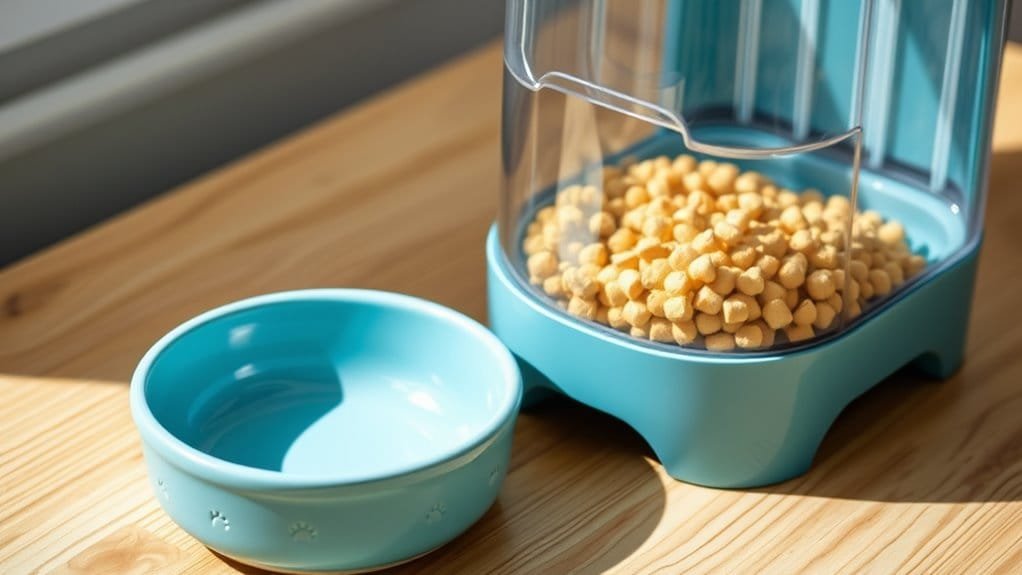
When it comes to basic food bowls, you’ll want to focus on the vital features that make feeding your hamster safe and convenient. Think of it like choosing a dinner plate – you need something that’s just right!
The best bowls are made from tough materials like stainless steel or ceramic that can handle your furry friend’s nibbling habits. They’re also super easy to clean, which means less work for you. A quality bowl like the Niteangel set offers glass construction that’s both durable and odor-free.
Size matters too – you’ll want a bowl that’s wide and shallow so your hamster won’t tip it over during their midnight snacks. It should be small enough for your pet to reach their food easily but big enough to hold a proper portion.
Ever noticed how messy hamsters can be? That’s why these bowls are designed to keep food contained!
The best part? These bowls are really versatile. You can use them for all sorts of hamster foods – from tiny seeds to fresh veggies.
And if you’ve got other small pets, like a rabbit or ferret, these bowls work great for them too. It’s like having a one-size-fits-all solution for your small pet feeding needs!
Automatic Feeder Technology
Automatic feeders transform the way you care for your hamster by combining smart technology with convenient feeding solutions. These smart devices use servo motors and timers to dispense food at set times, just like having a tiny robot butler for your furry friend! You’ll love how they help maintain regular feeding schedules, even when you’re away. A reliable system should include power-saving features to ensure continuous operation over extended periods.
| Feature | Benefit |
|---|---|
| Timer Control | Never miss a feeding time |
| Portion Control | Prevents overfeeding |
| Food Storage | Keeps food fresh longer |
When you’re picking an automatic feeder, you’ll want to think about what works best for your hamster’s needs. Most feeders run on batteries, so you’ll need to check them regularly – just like making sure your TV remote has juice! They work great with dry food and pellets, but you’ll need to measure the kibble size to make sure it flows smoothly through the dispenser.
Feeding Schedule Considerations
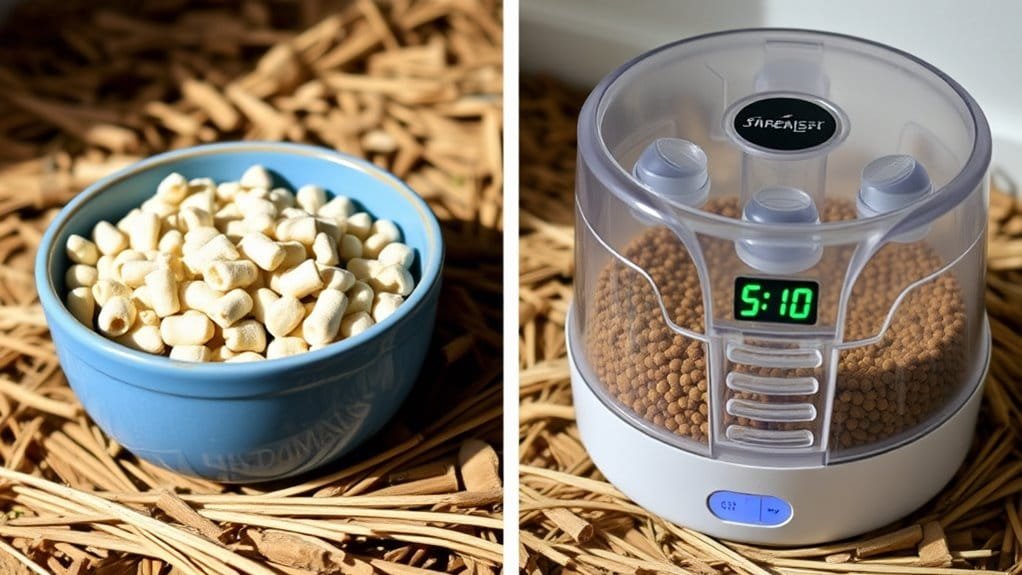
While automatic feeders can make life easier, understanding the right feeding schedule for your hamster is key to their health and happiness.
Think of it like this: you wouldn’t want someone randomly dropping food on your plate without checking if you’ve finished what you already have, right?
Most hamsters do well with daily feeding, about 1-2 tablespoons depending on their size. Fresh water should be available at all times for proper hydration.
If you’ve got a tiny dwarf hamster, they’ll need less food than their larger cousins – just like how a chihuahua eats less than a golden retriever!
You’ll want to check their secret stashes before adding more food, as these little hoarders love to pack away their meals for later.
Have you noticed your furry friend storing too much food? That’s your cue to cut back a bit.
You can feed them every other day instead, but never let their food supply run completely empty.
Remember, young hamsters and mommy hamsters need more frequent meals to keep up with their energy needs.
It’s all about finding the right balance for your particular pet!
Cost and Maintenance Analysis
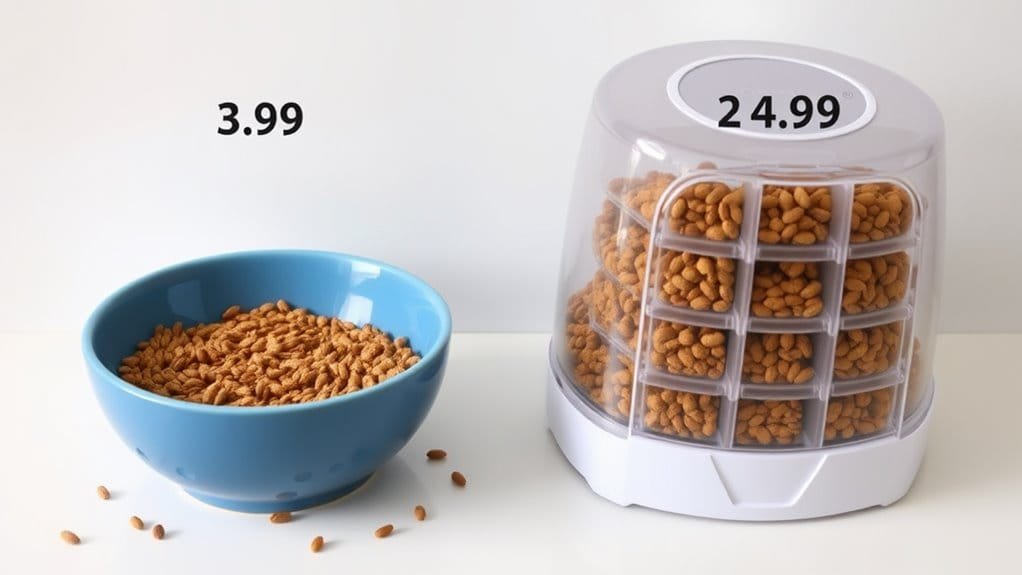
Every penny counts when choosing a hamster feeder, and your decision will impact both your wallet and your time.
Think of it like choosing between a basic flip phone and a fancy smartphone – sure, the automatic feeder has cool features, but it’ll cost you more upfront and needs more attention, just like that smartphone needs constant updates and charging. Some automatic feeders even include RFID recognition technology for a more personalized experience.
When you’re weighing your options, consider these key points:
- A food bowl is like a trusty bicycle – simple, reliable, and needs just basic cleaning
- An automatic feeder is more like a car – convenient but requires regular maintenance and occasional repairs
- Your budget isn’t just about the purchase price – think about ongoing costs like batteries and replacement parts
You’ll find that a basic food bowl costs under $10 and might last for years with proper care.
On the flip side, an automatic feeder could set you back $50-$200, plus the cost of batteries and potential repairs.
Species-Specific Dietary Requirements
Now that you’ve considered the financial aspects of feeders, let’s focus on what goes inside them. Your hamster’s diet needs to be just right, and different species have different needs.
You’ll want to make sure your feeder can handle both pellets and seed mixes – they’re the foundation of a healthy hamster diet. For dwarf hamsters, who tend to be prone to diabetes, you’ll need a feeder that helps you control portions, especially when it comes to sugary treats like fruits. Many commercial foods contain low nutritional fillers that should be avoided.
Syrian hamsters can handle slightly larger portions, but they still shouldn’t overdo it with treats. Think of it like this: your feeder should be like a helpful kitchen assistant, making it easy to give the right amount of food.
Both automatic feeders and food bowls should be able to keep pelleted food and seed mixes separate and dry. Remember, you don’t want moisture getting in there – wet food can spoil quickly.
And if you’re planning to offer fresh veggies or protein treats, you’ll need a separate dish that’s easy to clean daily.
Health and Safety Factors
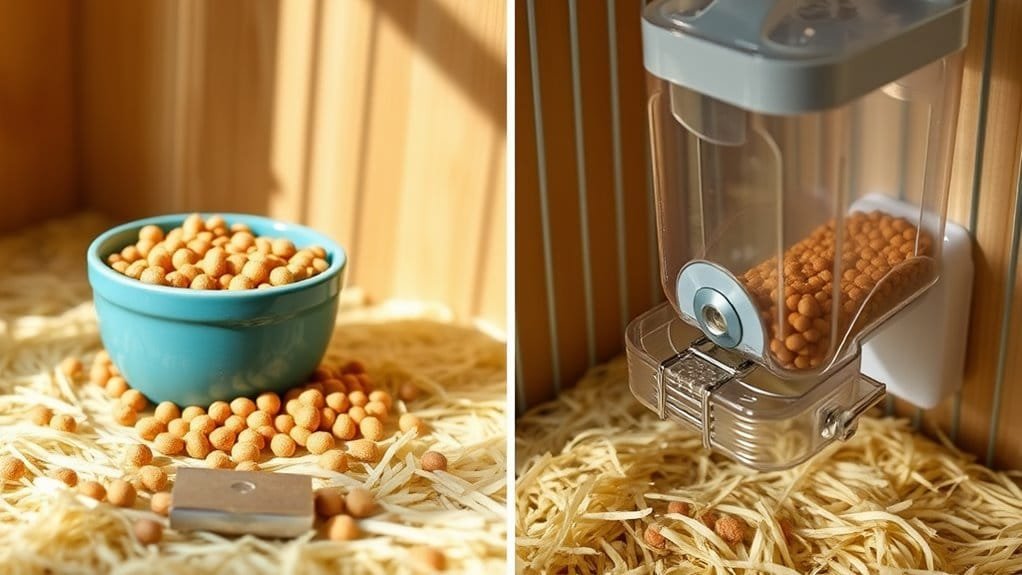
Keeping your hamster healthy and safe starts with choosing the right feeder design. While automatic feeders might seem convenient, they can pose risks like food spoilage and mechanical failures. Think of it like leaving a sandwich out too long – nobody wants moldy food, especially not your furry friend! Many modern feeders offer programmable meal times to help maintain consistent feeding schedules.
When selecting a feeder, you’ll want to focus on these key safety features:
- Tamper-proof designs that prevent your hamster from becoming an overnight snacker
- Easy-to-clean materials that won’t harbor harmful bacteria
- Pest-proof construction to keep unwanted visitors away from your pet’s food
You’ll need to monitor your hamster’s eating habits closely, whether you’re using a food bowl or automatic feeder. Have you noticed if your hamster seems stressed around feeding time? That’s a sign you might need to adjust your setup.
Just like us, hamsters can overeat when food’s too readily available, so it’s important to control portions. Remember to check automatic feeders regularly for proper operation – think of it as giving your car a quick inspection before a road trip.
Your hamster’s health depends on these simple but essential steps!
Best Practices for Feeding Success
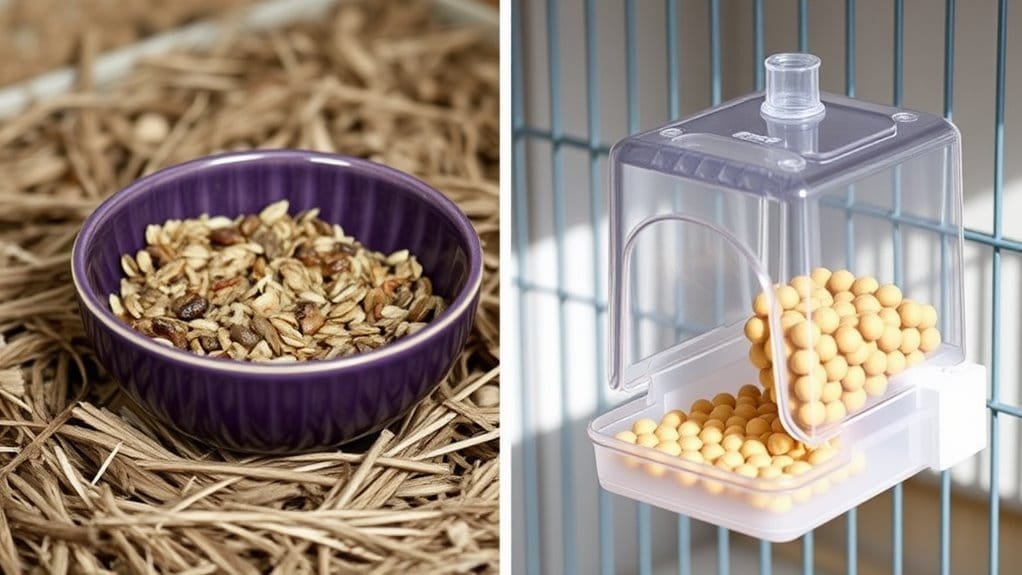
Successfully feeding your hamster goes beyond selecting the right equipment – it’s about implementing smart practices that work for both you and your pet. Think of it like setting up a tiny restaurant for your furry friend – you’ll want everything to run smoothly!
When it comes to feeding time, you’ll need to make smart choices about both the equipment and the routine. The Nadi hamster feeder, with its easy-to-clean ABS material, helps maintain proper hygiene for your pet’s dining area. Here’s a quick comparison to help you decide what works best:
| Feature | Food Bowl | Automatic Feeder |
|---|---|---|
| Timing Control | Manual filling | Programmable schedule |
| Maintenance | Daily cleaning | Weekly cleaning |
| Food Storage | Single portion | Multiple portions |
| Cost | Budget-friendly | Higher investment |
Remember to place your hamster’s feeder in a quiet spot where they’ll feel safe while eating. You’ll want to check it daily, just like you’d check your kitchen supplies. Keep the feeding area clean and dry – think of it as your hamster’s dining room! Don’t forget to store extra food in an airtight container, just like you’d keep your snacks fresh. With these practices in place, you’ll create a happy mealtime routine for your little friend.

